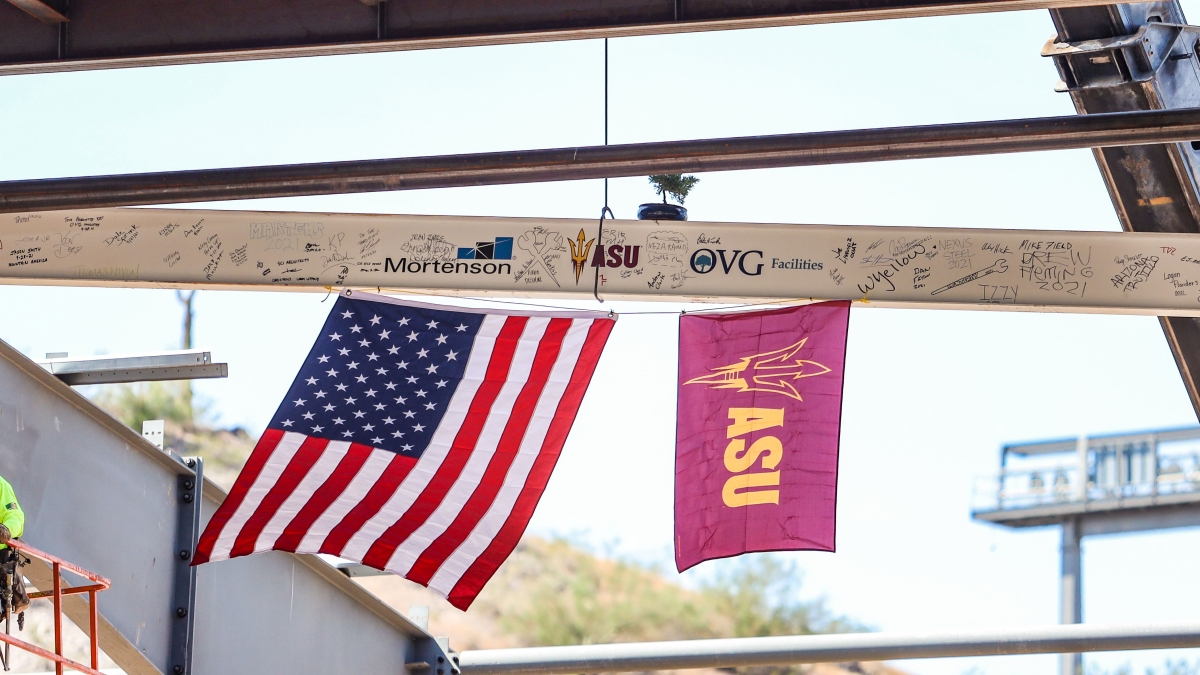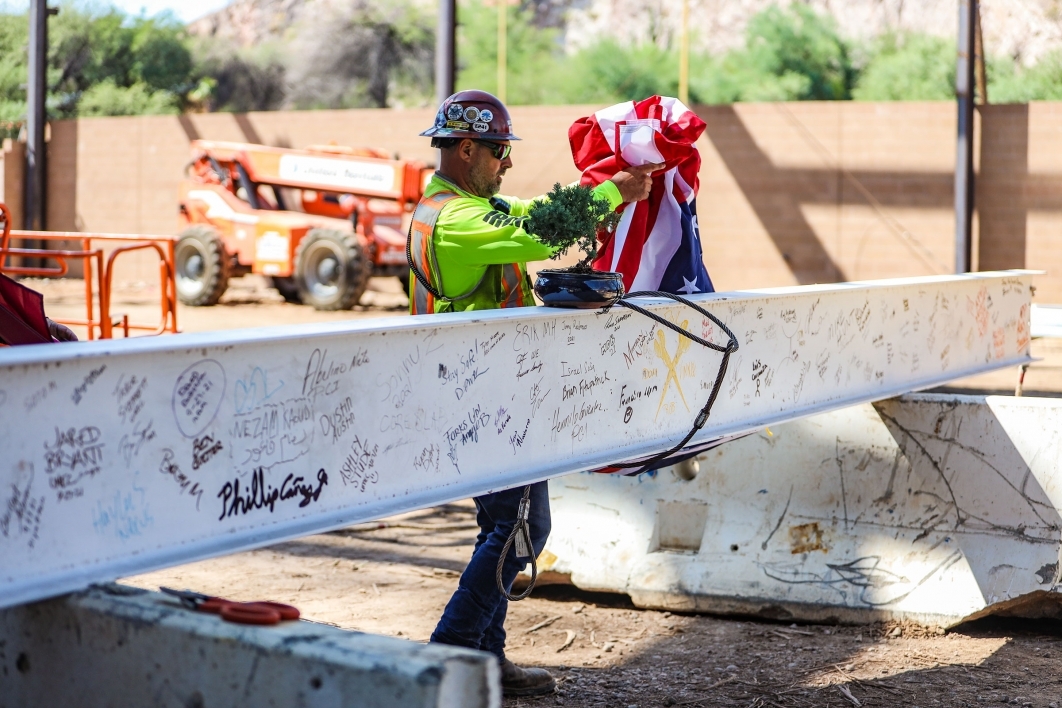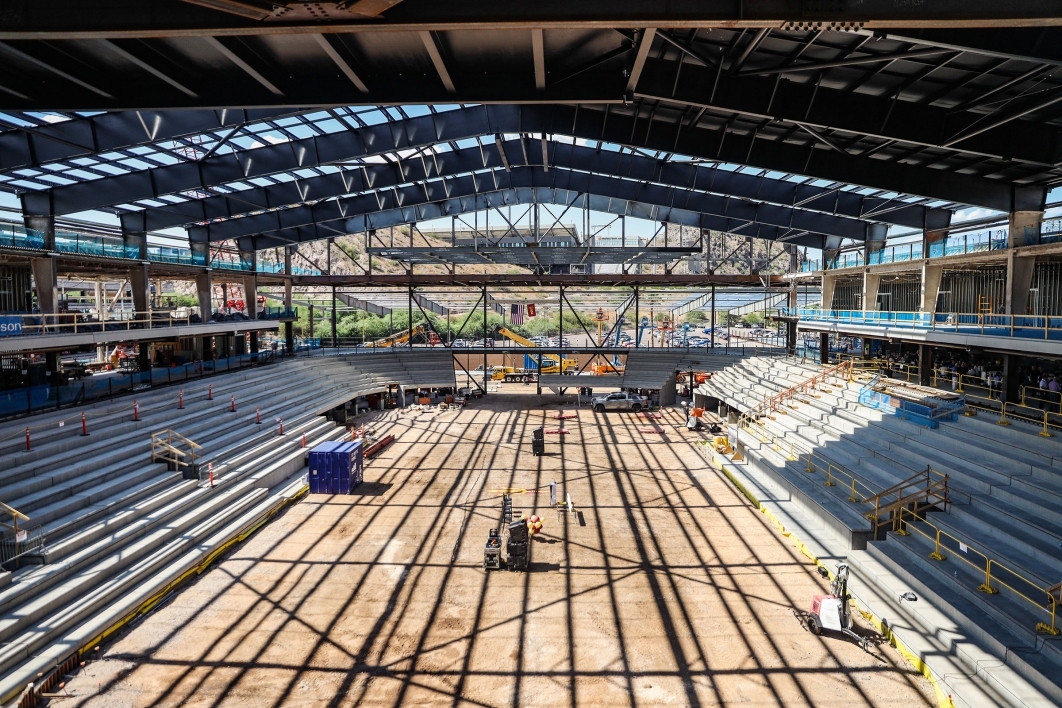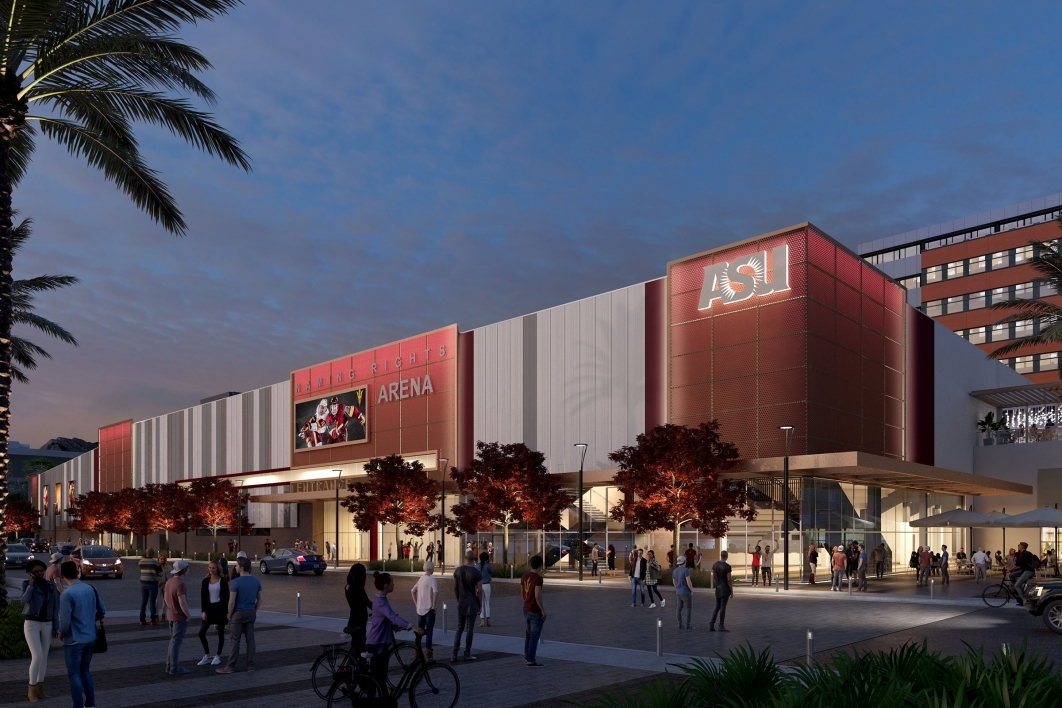Arizona State University and Sun Devil Athletics, in partnership with Mortenson and Oak View Group, hosted a “topping out” ceremony Tuesday to commemorate the last beam set in place on top of the new Multi-Purpose Arena on the Tempe campus. Set to open in late 2022, the new arena will host university and community events and serve as the future home for Sun Devil men's ice hockey, wrestling and women's gymnastics.
Located in the Novus Innovation Corridor, the arena’s steel structure was topped out, completing the final placement of 1,100 tons of steel. In addition, 6,980 yards of concrete have been poured since the project broke ground earlier this year.
The ceremony recognized the major construction milestone by placing a tree and flags atop the last structural beam that was lifted into place, a tradition acknowledging the successful partnership and project progress to date. Having worked more than 124,892 hours since groundbreaking without a single recordable injury, workers were recognized for their commitment to a safe project site.
"The Multi-Purpose Arena will be a very important piece of the Novus Innovation Corridor — a 'live, work, play' community that will span more than 10 million square feet," said Morgan R. Olsen, ASU executive vice president, treasurer and chief financial officer. "Sun Devils can cheer on ASU athletes in the arena housed in this sustainable, pedestrian-friendly, mixed-use development that provides community resources and economic value to the region. We're pleased that Mortenson and Oak View Group have partnered with us on this exciting arena project."
Ben Goetter, vice president, general manager at Mortenson, said, “This is truly an exciting time and an amazing milestone to celebrate in partnership with Arizona State University and all of our trade partners who are bringing this world-class facility to life. The topping out is always a rewarding moment to acknowledge all of the hard work and pay tribute to the team’s commitment to ensuring everyone goes home safely each day. We are excited to continue this momentum and look forward to seeing this transformational project complete next year.”
Oak View Group Facilities Chairman Peter Luukko said, “We look forward to bringing top-quality live entertainment and attractions to the new Multi-purpose Arena that will attract visitors to Tempe and unite the ASU community. With today’s milestone we move a little closer to that electrifying feeling of what it will be like inside the new ASU Multi-Purpose Arena and the future home of ASU Athletics.”
In addition to housing Sun Devil Athletics' events and competitions, the 5,000-seat arena, which also includes an adjacent community ice rink, will serve as a public venue for the university and community to host concerts, conferences, youth competitions, educational opportunities and more. The arena will feature a variety of luxury suites, group suites and a large club lounge, along with premium seating, a 942-seat student section and more than 8,000 square feet of state-of-the-art locker rooms, weight rooms and office space.
Some additional facts about the project and construction team on site:
- 650-plus team members have gone through safety orientation to make this project a success, with an average 150 people onsite at all times.
- Recently, the rooftop mechanical system, consisting of a quarter-million pounds, a quarter-mile of pipe and enough sheet metal to cover the outside of two average homes, was set in place.
- Approximately 6.5 miles of electrical conduit, underground and throughout the building, have been installed.
- Mortenson’s team and its trade partners are making an impact in the community — supporting various organizations through donations and volunteer time including Southwest Human Development, Hope Women’s Center and the Boys & Girls Club of Tempe.
Mortenson is providing development services and is the design-builder, with SCI Architects, the designer. Oak View Group will manage and operate the arena.
To see the construction progress of the new Multi-Purpose Arena, fans can view time-lapse videos and a livestream of the site here.
Top photo: The final beam is hoisted into the new Multi-Purpos Arena at the "topping out" ceremony. Photo by Sun Devil Athletics
More University news

ASU community exceeds goal, raises $835K for Valley of the Sun United Way
The Arizona State University community stepped up and raised over $835,266 for the Valley of the Sun United Way — exceeding the $800,000 goal for 2024.Of the total, $802,192.17 was raised through…

ASU launches online ocean futures undergraduate degrees
Our oceans make up three quarters of the planet’s surface and contain most of its biodiversity. Due to rapid and global changes, they are endangered — making more urgent a deeper knowledge of ocean…

ASU public affairs graduate programs rise to No. 11 in nation in US News & World Report’s 2025 rankings
Arizona State University rose to No. 11 nationwide for best graduate public affairs programs in U.S. News & World Report’s 2025 rankings, the magazine announced.The ranking, released April 8,…





